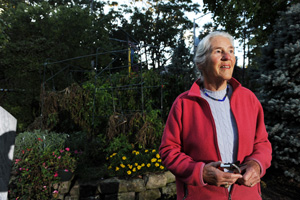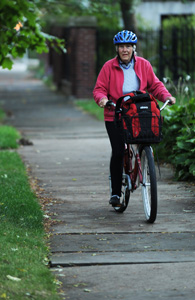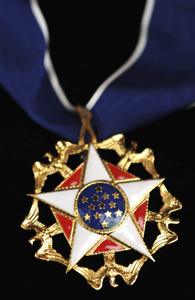Honor bound
It took years for Janet Rowley’s 1970s research to win acceptance, but now she’s collecting accolades—including the Presidential Medal of Freedom—for finding leukemia’s genetic link.
By Jason Kelly
Photography by Dan Dry
Ticking off an itinerary that included summer visits to Korea and the White House, with Hawaii still to come in October, Janet Rowley needs to consult her calendar. “…[A]nd then I got a call from Dr. Michelle LeBeau that I’d be awarded the Distinguished Scientist Award from the Association of American Cancer Institutes, which will be given October…19, I believe. I can check that.”

Janet Rowley
Rowley scoots her chair toward her desk, slips on her glasses, and slides a datebook onto her lap.
2009 At-A-Glance.
It’s black, with pink and yellow sticky notes here and there, a cluttered, colorful collection of things to do, places to go, and people to see, including the president of the United States. It’s not an unusual meeting for Rowley—a member of the President’s Council on Bioethics, she criticized George W. Bush’s ban on federal funding for stem-cell research and stood with Barack Obama in March when he repealed it. But even for her, the schedule has been filled with notable occasions lately. Between awards showered on her like ticker tape, she kept a previous commitment to spend three weeks in Korea working with a former postdoc. Rowley’s son David notes, “My father would advocate that she say no more frequently.”
She continues to flip through the appointment book. “Yes, the 19th. And then very late in July I got a call from Susan Sher, representing the White House, that I had been selected a recipient of the Presidential Medal of Freedom.” (pictured below) Rowley puts her spiral-bound calendar down. “That was awarded August 12.”
The accomplishments that inspired these honors date back to Rowley’s 1972 discovery that solved the mystery of an abnormally small chromosome found in leukemia patients. Her theory that this genetic mutation caused the disease provoked doubts at first, but her subsequent research linked specific chromosome abnormalities to different types of leukemia and validated the work Rowley says she began as “a hobby.”
Zigzagging through time, from recent weeks to decades past and back again, the 84-year-old Rowley connects the dots of her life and career that have led to the latest blur of recognition. “It’s been a wild few months,” she says. Really, it’s the natural progression of 60 years of being booked solid.
Despite her string of degrees, Rowley, U-High’42, PhB’45, SB’46, MD’48, had modest ambitions as a young doctor. Her days were no less crowded then, consumed with raising four boys and her favorite diversions—gardening, weaving, reading. Rowley’s medical work involved part-time clinical care for mentally disabled children. It was her ideal balance. “I thought I had it made.”
Although she finished medical school two years before her husband, Donald, “he was the scientist in the family,” Janet Rowley says. In 1959 Donald Rowley, SB’45, SM’50, MD’50, invented the gel electrode to monitor heart activity. Serving as his own research volunteer, Donald walked around their Hyde Park house with the electrodes stuck to his chest. In effect he donated his chest to science—and to Science, where it appeared in a photograph illustrating the new device.
Donald’s work took professional precedence, and Janet tended to the home and the children. Their shared scientific interest made for long dinner-table conversations that lasted well past dessert. After the boys had been excused and finished their homework or watching television, they often returned looking for leftovers. “And there my parents would still be, talking science,” says David Rowley, U-High X’72, a Chicago geology professor. “The level of engagement that they had in what they were doing was such that they easily could spend hours.”
During her husband’s 1960–61 sabbatical at Oxford, Janet Rowley’s engagement deepened as she ventured into the study of cytogenetics. She had worked with children who had Down syndrome, and the 1959 discovery linking the condition to an extra chromosome sparked her interest.
When they returned to Hyde Park, Rowley approached Leon Jacobson, MD’39, head of the University’s Argonne Cancer Research Hospital, about continuing her research at Chicago. In part because it did not overlap or interfere with existing work, Jacobson “gave me complete freedom,” Rowley says, and ever since she has “always had complete freedom to pursue things that I thought were interesting and important.”
Her research did not command more than part-time attention, as Obama noted in his remarks honoring Rowley with the Presidential Medal of Freedom. “I said—and I was quoted by the president as saying—that I looked on medicine as a hobby,” Rowley says. “That’s probably overstating it a bit, but not a whole lot.”
In retrospect it’s a fitting description. The crude methods of Rowley’s early research resembled assembling a puzzle or a stamp collection.
Rowley called them “paper dolls,” cutouts of chromosomes spread across the dining room table. “Often it was just scrap paper,” David Rowley says. “She would cut them all out and tape them down and label them and make notes on them.”
The chaotic comfort of a home with four boys might have made Rowley’s research seem informal, but it allowed her the luxury of thoughtful consideration without the stress of cultivating academic standing. As a research associate, “I didn’t have the pressure of trying to prove myself,” she says. “I had time to mull these things over—and I don’t come to conclusions rapidly. I could work in the garden and think about this.”

A second Oxford sabbatical in 1970–71 introduced Rowley to a technique called chromosome banding, which led to a new understanding of leukemia. Researchers had worked for years to divine the secret of the abnormal Philadelphia chromosome, named for the city where researchers Peter Nowell and David Hungerford first identified it in 1960. They showed that chromosome 22 was unusually small in the tumor cells of patients with chronic myeloid leukemia (CML). Existing methods could not explain why, but banding made it possible.
The process involves staining individual chromosomes to reveal their distinctive patterns of horizontal bands and highlight irregularities. Through banding Rowley could see that a “translocation” had occurred. A piece of chromosome 22 had broken off and fused to chromosome 9—a 9;22 translocation. That explained why the Philadelphia chromosome was so small; Rowley had found its missing piece.
It was a bracing breakthrough, but it was just the beginning. For several years after that 1972 discovery, Rowley and her Chicago colleagues found four translocations associated with leukemia and lymphoma. “I was so intrigued by what we were finding—that the chromosome abnormalities were consistent—that in ’75 I went full time,” says Rowley, who now has the mouthful title of Blum-Riese distinguished service professor of medicine, molecular genetics and cell biology, and human genetics. “Everywhere you looked,” Rowley says, “there were these funny-looking chromosomes.” Work had become “all-consuming.”
But what did the mounting evidence mean? As of 1975, three years after she found the first translocation, Rowley did not yet have complete confidence in her hypothesis that the chromosome damage triggered disease. At that time the translocations were considered an effect of cancer, not the cause, but the frequency of specific translocations consistent with particular types of leukemia indicated otherwise. Her “second ‘aha!’ moment” came in 1976.
Rowley had been working with a young Chicago doctor, Harvey Golomb, AB’64—now chief medical officer and dean of clinical affairs—to gather samples from about a dozen patients a year diagnosed with the rare acute promyelocytic leukemia (APL). Another University physician, James Vardiman, studied the pathology of the disease and recognized a common chromosomal link. “I remember Jim came to me one day and said, ‘You know, Janet, isn’t it interesting? We have two patients with a 15;17 translocation, and both of them have APL,” Rowley says. “Here was a rare form of leukemia with a specific translocation. That, for me, meant that translocations were in some way closely associated with that type of leukemia.”
Now she was convinced, but her conclusions about the genetic breakdowns she identified as causing the disease were received with skepticism, if not outright resistance. The New England Journal of Medicine refused to publish her findings. “She argued, and was ultimately proven to be correct, that the broken chromosome was not a byproduct of the process but was in fact the cause of the process,” says Chicago professor of medicine Richard L. Schilsky, MD’75, who remembers Rowley’s lectures stoking his interest in cancer research.
Rowley became “a missionary” for her point of view, an understated but steadfast advocate seeking conclusive evidence. She organized a series of workshops beginning in 1979, when a dozen physicians from the United States and Europe gathered in Finland, combining data that showed the consistency of translocations in leukemia. Over the next decade further advances strengthened the genetic link.
“It’s a perfect example of ‘virtue triumphs,’” says U of C professor of medicine Michelle LeBeau, a colleague of Rowley’s since 1981. “You see how committed people have to be to advance a hypothesis that’s not the mainstream with absolute faith.”
Rowley showed the same commitment to her scientific ideals as a member of the President’s Council on Bioethics. She was often at odds with Bush administration policies and with the council’s first chair, Chicago bioethicist Leon Kass, SB’58, MD’62. Other critics were replaced on the council, but Rowley remained for its entire existence from 2001 to 2009, which she attributed to her style of dissent. “I can be sharply critical of things, but never depart too far from being civil,” she told Nature Medicine in 2005. “I’m trying to remain as a voice of reason.”
Rowley outlined her position on stem-cell research last spring in U.S. News & World Report, noting the 400,000 human embryos kept in the freezers of in-vitro fertilization clinics. “Many are destined to be thawed and discarded and thus die. It is a true moral dilemma, but science offers a way to bring something good from a flawed situation,” she wrote. “The parents of these embryos could allow them to die, or they could donate the embryos for research that someday might benefit patients with incurable diseases. This is a high purpose, one that promotes both human health and understanding.”
Even after she went full time, science was never Rowley’s only interest. She and her husband were avid hikers, trekking in Nepal, the Andes, Alaska. Later they put down their backpacks and took up snorkeling. At home their lives revolved around their four sons—and now, their five grandchildren; Rowley has said the money from the $500,000 Gruber Prize will replenish their recession-depleted college funds.

Tragedy has also touched their family. In 1983 the Rowleys’ eldest son, Donnie, drowned in Lake Michigan. Amid the devastation Rowley’s personal and professional responsibilities kept the grief from overwhelming her: “I could not fall apart.”
Work and family remain her touchstones. Rowley commutes about a mile between her home and office by bike, as she has for more than 60 years, with only an occasional mishap. About eight years ago, dressed up to speak at the biological-sciences and medical-school graduation ceremony, Rowley caught her high heel in a pedal and crashed at 57th and University. With a police officer’s help, she dusted herself off and continued on her way.
That story echoes the unpretentious determination Rowley’s colleagues see in her. “She is completely focused and driven in her science,” Schilsky says. “This is a woman who, over the course of her career, could have had any number of high-profile administrative or leadership jobs—she could have been anything. But she always decided to stay focused in the laboratory.”
Her focus advanced the understanding of leukemia and, by extension, revolutionized how to treat it. The drug Gleevec, introduced in 1998, inhibits the growth and production of abnormal cells in chronic myeloid leukemia patients. It’s the practical culmination of Rowley’s original genetic discovery. “The real success story is Gleevec in CML,” she says. “People who have that type of leukemia have a drug that extends life just magically.”
Researchers Brian Druker, Nicholas Lydon, and Charles Sawyers won the 2009 Lasker clinical medical research award—considered the American Nobel Prize—for developing Gleevec. When Rowley received the Lasker in 1998, the Chicago Tribune called it “sweet vindication” after years of doubt. This year’s winners reflect the enduring reach of Rowley’s research. “Basically,” Schilsky says, “those people could not have gotten the award without the work that Janet did 40 years ago.”
She continues that work today, wrestling with the question of what other genetic changes—in addition to translocations, which do not always cause leukemia—lead to malignancy. As she has for decades, Rowley takes her work home. “I’m always amazed that she works, typically, until 10:30, 11 at night,” David Rowley says. “Dinner and all that, then out will come manuscripts to review, or papers, and proposals that require editing. She’ll sit there and work for hours in the evening.”
New insights don’t come in the garden much anymore, but often at the family’s Indiana lake house, where she enjoys “sitting on the deck, watching the waves, or the boats go by, the birds flying,” Rowley says. “It gives you a chance to do some free association.” Not that her schedule allows much time for silent contemplation. Transitioning her office to the new Knapp Center this year, along with the accumulating honors, have stuffed her datebook.
During a week in October she has plans to accept one award on Monday in Washington and another on Friday in Hawaii. It’s all noted in her calendar if she needs to refer to it, but there are more pressing items on Rowley’s agenda. Her next meeting starts soon.WRITE THE EDITOR
DISCUSS THIS ARTICLE
E-MAIL THIS ARTICLE
SHARE THIS ARTICLE
RELATED READING
- "Dr. Janet Rowley wins Presidential Medal of Freedom"
(Science Life blog, July 30, 2009) - "Janet Rowley, Tony Perkins debate embryonic stem cell research"
(U.S. News & World Report, Mar. 23, 2009) - "Profile: Janet Rowley"
(Nature, Dec. 29, 2005) -
RELATED LINKS
"Why Chicago: Janet Rowley"
Video of Rowley talking about her garden
